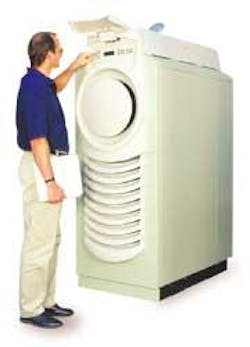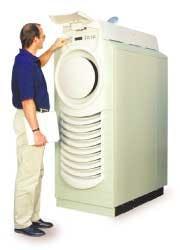Safeguarding power supply is a major concern on unmanned platforms. Disruption can cost thousands of dollars per hour in terms of lost production, and thousands more to rectify through unscheduled site visits.
The standard preventive measure is excess redundancy, in the form of multiple, volume-intensive generating sets and their associated switchgear. These power plants are often oversized for the application, or run at part-load, in an attempt to extend mean time between failures. Costs are driven up further in the case of diesel-driven sets, due to the need for frequent shipments of replacement fuel.
null
Last year, Wintershall opted for an alternative approach on its new Q4-C platform in the Dutch North Sea. This has been equipped with a Capstone MicroTurbine, which was installed by Los Angeles-based Capstone's distributor in northwest Europe, Geveke Power Systems.
The MicroTurbine comprises an aerospace-derivative jet engine and integrated generator, equivalent in size to a household refrigerator and weighing around 500 kg. The generator, which features patented air bearings, is designed for continuous duty without the need for lubricants or coolants, and is fueled offshore by wellhead gas.
Geveke, located in Papendrecht, says that numerous offshore applications of this technology have over time provided continuous power with very low NOx emissions (down to 9 ppm, or 10gr/GJ), with no requirement for exhaust clean-up devices. As the equipment features just one moving part and no gearbox, pumps or radiators, maintenance needs are minimal, with replacement of a filter or injector cleaning typically following one to two years of continuous full-load or load-following service.
Q4-C, situated 20 mi offshore Egmond-aan-Zee, is a three-deck platform that can produce gas at up to 6 MMcm/d. Wintershall chose Capstone's microturbines, based on positive experiences with a wellhead gas-fueled Capstone C30 on its Q8-A platform. Geveke, which is also a distributor for Caterpillar, worked with Wintershall's preferred electrical contractor, Vageri, to design the prime power solution. This included four gas-fueled C60 MicroTurbines, one Caterpil-lar diesel generating set as backup, and a power management system employing a Capstone PowerServer networking device.
The project's mechanical and process contractor KCI, developed the platform's gas treatment equipment. This is designed to remove liquids and to bring the gas pressure down in stages from 250 bar to the 5 bar required for gas-fueled operation of the microturbines.
In unmanned mode, the average load on the platform of 120 KW is spread evenly among the three microturbines. If one should fail, the other two should seamlessly pick up the load, while the fourth re-establishes N+1 turbine load as a safety margin. Each microturbine is designed to allow load sharing without the need for switchgear or other hardware. The PowerServer function provides automatic duty switching, ensuring that all the microturbines run up the same amount of operating hours. It also enables more efficient load balancing, i.e. two 60 KW turbines run at full load rather than running four at 50% load. For Q4-C, Siemens additionally developed a remote power and diagnostics management system covering the microturbines, the Caterpillar engine and zero-fluctuation transfer/synchronization, all controlled from Wintershall's operations center in The Hague.
According to Sven Fransen, Capstone Product Manager at Geveke Motoren, the Capstone microturbines can run on natural gas, flare gas and wet gas, with a wide range of compositions (i.e. low to high BTU gas, 30-55 MJ/cu m). "This means they are also suitable for many different geographical loca- tions, including West Africa, where excessive flaring is such a problem. We did a calculation showing that even a battery of 20 x 60 KW microturbine units can be cost-effective. Taking into account factors such as low maintenance, free fuel, reduction in gas flared, and 100% availability, the systems could pay for themselves within one year.
"Payback on offshore installations is typically within one to one and a half years. Experience from the installed base of over 2,500 units worldwide has shown that these units can run for 40,000 hr continuously – equivalent to five years – before an overhaul is required.
"Offshore clients typically have concerns over reliability. As a trial run, Wintershall left one microturbine in an onshore installation. It ran continuously for six months, so they were convinced. A regular supply of good quality gas is important. If the turbine stops, it's usually due to external causes, such as the fuel treatment system, the dew point not being correct, or the electronics being out of kilter. But we work with the field operator and its preferred contractors to dimension these requirements, often at their laboratories."
Geveke is currently training its network of dealers in Europe to operate the Capstone equipment.
"We are still very much on a learning curve," Fransen admits, "as applications vary widely. Some operators will have fuel available on their platforms, while others will have a lower power demand, or will be looking to cut maintenance costs by replacing their generating sets with our equipment. The Capstone systems do not vibrate, so no special skids are required. This means an operator can save 900 kg in weight when switching from diesel gen sets."
The company is also one of five dealers approved by Caterpillar to configure its gen sets to zone 2 hazardous applications. Its current or recent offshore projects include installation of emergency and essential power plant on Shell's Bonga FPSO (Nigeria), and the emergency power plant for the two platforms under construction for Sakhalin II.




